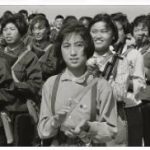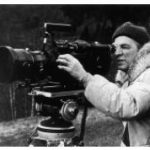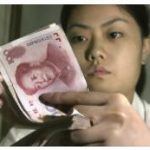The affirmation of a national industry
At the end of the 1920s, other companies were founded, fantastic films and martial arts were established, but also serial products, among which Huo shao Honglian si (1928-1931, Fire in the temple of the red lotus), 18 episodes directed by Zhang Shichuan for Mingxing, which achieved great success.
In 1929 only about ten percent of the 500 films screened in China were Chinese production. The advent of sound was also to stimulate national cinema, as only a minority of spectators was able to read the captions. In a country dominated by Jiang Jieshi’s Guomindang – but in which intellectuals were closer to Mao’s communist left – directors and screenwriters (chief among them Xia Yan) managed to make significant works both for Mingxing productions and for rival Lianhua., created in 1930 by the owner of a chain of cinemas. Among these works, often melodram-mi with a strong breath, we should remember Shennü (1934, The Goddess) by Wu Yonggang for Lianhua, the story of a poor girl who must prostitute herself for the love of her son (starring Ruan Lingyu, the beautiful and intense ‘Chinese Garbo’, of which, many years later, with the 1992 film Ruan Lingyu, also known as The actress, Stanley Kwan, director of Hong Kong, would tell the dramatic story), Chun can (1933, Spring silkworms) by Cheng Bugao, Yu guang qu (1934, The Song of the Fishermen) by Cai Chusheng for Lianhua (first prize at the Moscow Festival in 1935) and Malu tianshi (1937, Angels of the road) by Yuan Muzhi for Mingxing, set among thieves, prostitutes and itinerant players. The Japanese conquest, which began in 1931 with the invasion of Manchuria (with episodes of heroic and desperate resistance, narrated for example in Fengyun ernü, 1935, Children of a troubled age, by Xu Xingzhi), would culminate in 1937 with the fall of Shanghai and the Nanking massacres, marking the end of a ‘ an era full of tension and fervor for Chinese cinema and culture. All productive activity soon ceased and even after the surrender of Japan (1945) the end of the world war marked only the beginning of a bloody civil war between the official forces of Jiang Jieshi’s Guomindang (supported by the USA) and the rebels of Mao, officially supported by the USSR since 1949.
But if between 1927 and 1930 about 400 films had been produced, already in 1929 the Guomindang had created a censorship office and in 1931 a National Commission for cinematographic censorship, tightening control over production and the scripts themselves and leading to persecution. left-wing filmmakers. Around the same time, the Left League for Performing Artists was born, which sought to promote proletarian cinema and anti-regime films, such as Shen Xiling’s Shanghai ershisi xiaoshi (1933, Twenty-four Hours in Shanghai), an investigation into difficult living conditions in the big city. The ‘politicization of cinema’ developed, between 1932 and 1936, also in the affirmation of a nationalist spirit opposed to the strong Japanese influence, while the diatribe between naturalism / stylization was joined by that between silent cinema – produced until 1936, especially by Lianhua – and sound cinema. Lianhua included numerous intellectuals linked to the literary movement of May 4, 1919, convinced of the need for culture and the arts to free themselves from both foreign influences and an oppressive national tradition, in order to create new forms of expression of Chinese cultural characteristics.. Critics generally agree in dividing films from the early 1930s into three groups: anti-imperialist works, such as Sun Yu’s Xiao wanyi (1933, The Toy); anti-feudal works, such as Kuang liu (1933, Wild Creek) by Cheng Bugao; ‘denouncing’ works, such as Nüxing de nahan (1933, Shouts of Women) by Shen Xiling.
Those between 1930 and 1937 were years of great fervor in the arts, culture and cinema. In particular, in the field of cinematographic publications, a magazine, “Qingqing dianying”, was born in 1934, which would soon acquire great authority.
From silent to sound (and speech)
According to intershippingrates.com, the 1930s had begun with a historic date for Chinese cinematography, the release of the first sound film, Genü Hong Mudan (1930, The Red Peony Singer), directed by Zhang Shichuan for Mingxing, which, although with technical limitations, obtained wide success. Despite the high cost, attempts to permanently introduce sound continued and the following year Mingxing managed to produce her second fully spoken film, Jiu shi, jinghua (The Old Capital), still directed by Zhang Shichuan, which had preceded it. from three sound films of other productions. The introduction of sound was accompanied (and facilitated) by the adoption of a national language also for cinema, in which music and songs related to theater and opera converged, in a ideal union of the main and most popular forms of entertainment in the country. However, the historical phase was full of profound unrest, on the one hand due to the new Japanese attacks and the bombing of Shanghai, on the other due to the conflict between nationalists and communists. The latter continued to enjoy a broad consensus among intellectuals, who, after the formation of the Left League for Performing Arts, founded in 1931, the League of Left Playwrights, immediately targeted by the Guomindang, who in February of the same year eliminated twenty-four representatives, including writer Rou Shi. Within the film industry this state of affairs led to the entry of the Chinese Communist Party into the Mingxing in 1932, who soon produced some of the early works of Cheng Bugao and Shen Xiling. Those years, lively and full of hope, saw the strong drive for realism and commitment coexist with the affirmation of a national star system, influenced by the US one.
But this climate was abruptly interrupted by the Japanese occupation of Shanghai in 1937, which forced many entertainers to take refuge elsewhere, in Hong Kong, Hankou or Chongqing. An echo of this drama seems to be felt in Shen Xiling’s film Shizi jietou (1937, Crossroads), with its young people unemployed or fighting the Japanese, and also in the intense, profound sadness of Yuan Muzhi’s Malu tianshi; two of the latest important titles in a phase that saw the advance of the Japanese occupation, against which the alliance between nationalists and communists was defined.
In the following years it was the local fronts of the Second World War that determined an obvious production recession, although at least two other important works must be recorded, Ye shenchen (1941, Deep Night) by Zhang Shichuan and Qiu Haitang (1943, Begonia d ‘ autumn) by Ma-Xu Weibang.








